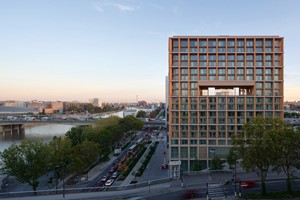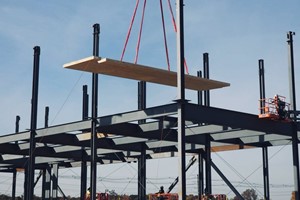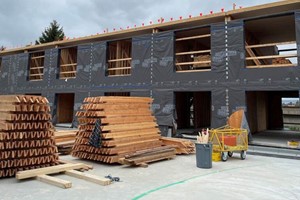When sourced from sustainably managed, climate-smart forests, biobased buildings can be hugely instrumental in combating climate change, driving investment back into forests while simultaneously creating a carbon sink in the built environment. There are five reasons why sustainable timber must become one of Earth’s core building materials, these are:
- Timber building materials store vast amounts of carbon
Trees absorb carbon from the atmosphere and much of that carbon remains stored within the tree's woody biomass even once they’re cut down and processed into wood and used for anything from the frame of a building to a door or kitchen unit. Once that wood reaches the end of its natural use, providing it’s recycled into another long-life product – a timber facade is turned into bio-insulation, for example – that carbon remains stored within the structure it has morphed into.
So, while traditional buildings made from concrete and steel are expected to produce around 2,000 metric tons of CO2 emissions, an equivalent timber building can match this in carbon storage.
And, not only does timber construction benefit the environment by helping to cut down carbon emissions by substituting for carbon-intensive materials, it can also create demand for wood from sustainable well-managed forests, thereby paying for management that reduces the likelihood of forest fires and providing habitat for wildlife.
- Timber building materials are durable and even fireproof
Using the latest manufacturing processes, wood can now be engineered into mass timber, where the wood is layered and pressed together to create extremely tough and resilient wooden structures. Different incarnations of mass timber are now being used to replace many carbon-emitting, highly durable construction materials, including concrete and steel.
Mass timber is even proven to be fire and earthquake-resistant. It’s difficult to ignite and can withstand severe earthquakes and explosions.
The Climate Smart Forest Economy Program (CSFEP) is working with Easy Housing, for example, to scale timber-based, flexible, affordable housing solutions. Easy Housing’s flexible, prefabricated timber homes can withstand natural disasters, such as floods, earthquakes and category 4 hurricanes, and they are termite resistant.
- Timber buildings are easy and cost-effective to construct and run
Wood is also lighter and – because it can often be prefabricated off-site – easier to manoeuvre and construct than concrete and steel. And, as engineered wood is easier to manufacture than less green alternatives, speeds up the build process and creates a healthier, safer and more pleasant working environment, it can work out as cost-effective too. It could even become cheaper than concrete and steel in the future.
“The economies of scale that have developed for concrete and steel don’t yet exist for the mass-timber industry, but we’re getting pretty close to economic parity with steel and concrete for particular building types, say six to 12 storeys high,” explains Alan Organschi, Director, Innovation Labs at Bauhaus Earth and principal and partner at Gray Organschi Architecture. “This is because with such a lightweight and workable material as wood, smaller crews using lighter tools and less intensive material handling equipment can assemble wooden components pre-manufactured to precise tolerances in off-site factories. You have to look at the entire construction process from beginning to end to properly assess and capture the potential cost benefits of these new bio-based material systems.”
The timber frames of Easy Housing's affordable housing solutions are prefabricated in local carpentry workshops across East Africa, for example, and the average-sized project can be completed within three months.
Timber is also a more effective insulator than metals, glass and concrete, so timber buildings require less heating in winter and less cooling in summer, making them more energy and cost-efficient to run too.
- Timber construction creates jobs and boosts the economy
From sustainable forest management to carpentry, encouraging the use of locally sourced, sustainable wood creates jobs and benefits local economies.
Recognizing the environmental and economic impact of using wood in construction, some national governments are now moving to mandate that all new buildings must be constructed partially from timber. The French government now requires all new public buildings to contain at least 50% wood and 20% of new homes built in Amsterdam must be built of timber or bio-based materials from 2025.
As wood becomes the go-to construction material, it will jump-start mass timber supply chains worldwide. We will see more factories producing cross-laminated timber (CLT), the most commonly used mass timber product today, but this must be done in a climate-smart way.
In line with the very ethos of a climate-smart forest economy, which ensures that the climate contribution is indeed net positive, the supply of sustainable wood to these factories must scale in proportion to demand. By applying holistic carbon measures across the sink, storage and substitution functions of the timber value chain and avoided deforestation legislation and certification schemes, we have to hand the tools necessary to avoid demand leading to the degradation of the forest resource.
In East Africa, CSFEP is working to develop the climate-smart forest economy in Kenya, Tanzania and Uganda. It’s working with architecture, engineering and construction company BuildX Studio to create a new regional value chain and market that will literally build demand for sustainable timber in construction and help support reforestation. The CSFEP is engaging relevant stakeholders interested in supporting and investing in a climate-smart forest economy to develop a network that can support growth and help address barriers in the value chain.
- Timber buildings make for healthier living and working environments
A growing body of evidence shows that people like to be connected to nature and buildings designed to be biophilic, or in tune with nature, respond to this desire. We benefit physically and mentally from living and working in timber buildings.
A study by Rice et al. found that people seem to have an innate understanding that wood creates healthier environments and naturally view timber-built rooms as warm, comfortable, relaxing, inviting and natural spaces. While this Slovakian study found that being in a building made from natural materials and fabrics positively impacts work efficiency and creativity and this research found that a hospital waiting room constructed from wood, helps to reduce the stress levels of visitors.














